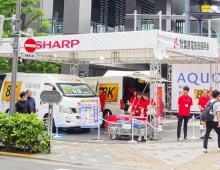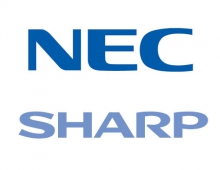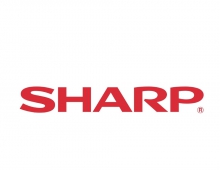
Sharp Concentrator Solar Cell Features The World's Highest Conversion Efficiency
Sharp claims it has achieved the world?s highest solar
cell conversion efficiency of 43.5% using a concentrator
triple-junction compound solar cell.
These solar cells are used in a lens-based concentrator
system that focuses sunlight on the cells to generate
electricity.
Compound solar cells utilize photo-absorption layers made from compounds consisting of two or more elements, such as indium and gallium. The basic structure of this latest triple-junction compound solar cell uses Sharp's proprietary technology that enables efficient stacking of the three photo-absorption layers, with InGaAs (indium gallium arsenide) as the bottom layer.
To achieve this latest increase in conversion efficiency, Sharp capitalized on the ability of this cell to efficiently convert sunlight collected via three photo-absorption layers into electricity. Sharp also optimized the spacing between electrodes on the surface of the concentrator cell and minimized the cell's electrical resistance.
This latest Sharp research and development efforts were part of the "R&D on Innovative Solar Cells" project promoted by Japan's New Energy and Industrial Technology Development Organization (NEDO), Japan's largest public management organization for promoting research and development.

Measurement of the value of 43.5%, which sets a record for the world?s highest concentrating conversion efficiency, was confirmed at the Fraunhofer Institute for Solar Energy Systems (ISE) in Germany.
Because of their high conversion efficiency, compound solar cells have been used primarily on space satellites. Sharp's aim for the future is to apply this latest development success into concentrator photovoltaic power systems that can efficiently generate electricity using small-surface-area solar cells and make them practical for terrestrial use.
Compound solar cells utilize photo-absorption layers made from compounds consisting of two or more elements, such as indium and gallium. The basic structure of this latest triple-junction compound solar cell uses Sharp's proprietary technology that enables efficient stacking of the three photo-absorption layers, with InGaAs (indium gallium arsenide) as the bottom layer.
To achieve this latest increase in conversion efficiency, Sharp capitalized on the ability of this cell to efficiently convert sunlight collected via three photo-absorption layers into electricity. Sharp also optimized the spacing between electrodes on the surface of the concentrator cell and minimized the cell's electrical resistance.
This latest Sharp research and development efforts were part of the "R&D on Innovative Solar Cells" project promoted by Japan's New Energy and Industrial Technology Development Organization (NEDO), Japan's largest public management organization for promoting research and development.

Measurement of the value of 43.5%, which sets a record for the world?s highest concentrating conversion efficiency, was confirmed at the Fraunhofer Institute for Solar Energy Systems (ISE) in Germany.
Because of their high conversion efficiency, compound solar cells have been used primarily on space satellites. Sharp's aim for the future is to apply this latest development success into concentrator photovoltaic power systems that can efficiently generate electricity using small-surface-area solar cells and make them practical for terrestrial use.





















